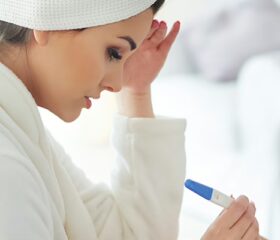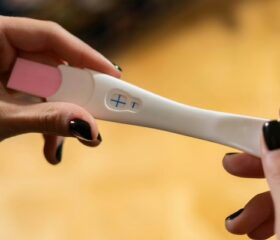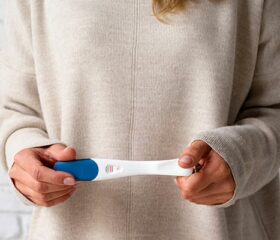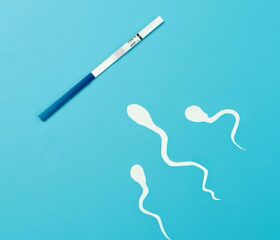What Are Your Chances of Pregnancy After Getting a Positive Ovulation Test?
If you’re trying to conceive and just saw a positive result on your ovulation test, you’re probably excited (and maybe a little anxious). How likely is it that you’ll actually get pregnant this month?
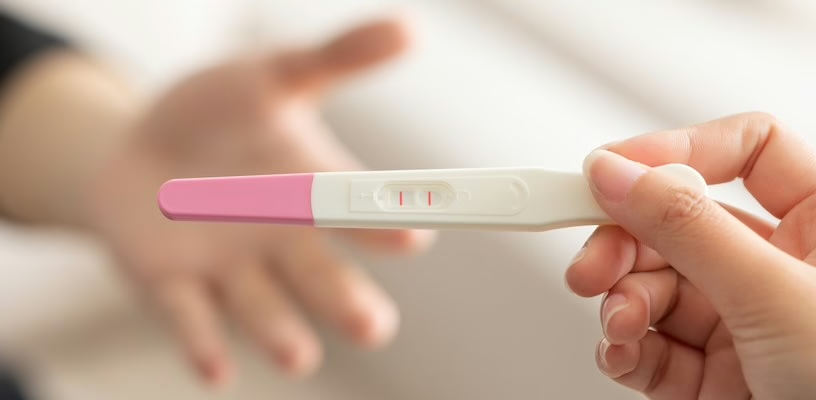
- How do ovulation tests work?
- What does a positive ovulation test result look like?
- What are your chances of getting pregnant after a positive ovulation test result?
- What are the next steps after you see a positive ovulation test?
- Does a positive ovulation test always mean you’ll ovulate soon?
- What else affects your chances of getting pregnant?
- How to increase your chances of getting pregnant
- When should you take a pregnancy test after a positive ovulation test?
- Final thoughts
Many women use ovulation tests, also known as ovulation predictor kits (OPKs), to find out when they’re most fertile.
While ovulation tests are very accurate, they’re not perfect, so you may be wondering how likely it is that you’ll get pregnant after seeing a positive result.
Read on to learn what a positive result truly means and what your chances of pregnancy success after getting one are.
How do ovulation tests work?
Ovulation tests are simple, at-home urine-based tests designed to help you monitor your cycle and predict when ovulation is about to occur. They work by detecting a hormone in your urine called luteinizing hormone (LH).
During the first half of your menstrual cycle, as your ovarian follicles mature, they produce estrogen. When your estrogen levels reach a certain threshold, they signal to your pituitary gland to release a surge of LH.
This LH surge is the trigger for your body to release an egg from one of your ovaries (this is what ovulation is). During the surge, you’ll get a positive result if you take an ovulation test.
Your LH levels start dropping about a day or two after the surge, and you begin producing the hormone progesterone, which prepares your body for a potential pregnancy. 1
When can you start using ovulation tests?
If you have a regular 28-day menstrual cycle, you should start using OPKs 5–6 days before your next predicted ovulation date (usually around day 14 in a 28-day cycle).
However, ovulation varies from woman to woman, and it’s normal for the exact day you ovulate to be a little earlier or later than day 14. You’ll probably need to use OPKs regularly over the course of several cycles to get a better idea of what a positive ovulation test result looks like for you.
If you have irregular periods and want to track your ovulation, you may need to test over a longer period of time or get extra assistance from your doctor.
What does a positive ovulation test result look like?
On most ovulation tests, you’ll see two lines: a control line and a testing line.
The testing line will be darker than the control line if your ovulation test is positive. This usually means you’re in the LH surge, and ovulation will happen within the next 36 hours. 1
If you see a faint line on your ovulation test, it’s likely that you haven’t entered your LH surge yet, or your ovulation is over.
What do positive results look like on digital tests?
Digital tests make it a little easier to interpret the results. They’ll often display a clear “yes” or “no,” or a sign (like a smiley face) if you’re ovulating. 2
Some more advanced digital ovulation tests go one step further by showing you the days when you’re most likely to conceive. This may be displayed on a synced app.
What are your chances of getting pregnant after a positive ovulation test result?
Your chances of getting pregnant after a positive ovulation test result depend on when you have sex.
Check out the table below to see what your chances of pregnancy success are during your fertile window (the period that lasts from 5 days before ovulation until just afterward, when you’re most likely to get pregnant):
| Day | Conception success rate |
|---|---|
| 3 days before ovulation | 27% |
| 2 days before ovulation | 33% |
| 1 day before ovulation | 41% |
| Day of ovulation | 20% |
| 1 day after ovulation | 8% |
Once you’re 2 days past ovulation, your chances of getting pregnant drop to almost nothing.
What are the next steps after you see a positive ovulation test?
Once you get a positive result on your ovulation test, the next step is to get into the bedroom!
The table above shows when your odds of conception are highest, but you don’t have to try just one time. If you try to have sex at least every other day, you’ll have the best chances of pregnancy.
In fact, you can also try to have sex every day if you want. While research suggests it’s no more effective than having sex every two days, there’s no harm in trying. 3
Why is your fertile window so long?
As you may remember from biology class, a mature egg is only viable for 24 hours after it’s released into your fallopian tube, so how is your fertile window so long?
The answer is that sperm can survive inside your reproductive tract for up to five days. 4 If you have sex at any point in the five days before you ovulate, the sperm might still be viable when you do.
Does a positive ovulation test always mean you’ll ovulate soon?
OPKs detect the presence of LH in your urine. While that does often indicate that you’re approaching ovulation, it isn’t a guarantee.
Several other factors could cause you to get a false positive ovulation test result, such as:
- Polycystic ovary syndrome (PCOS): This hormonal condition can sometimes cause women to have elevated LH levels throughout their cycles. 5 As a result, PCOS makes it difficult to track when you’re ovulating. If you’re trying to get pregnant with PCOS, you’re best off speaking to your doctor for tailored guidance.
- Pregnancy: When you’re pregnant, your body begins producing the hormone human chorionic gonadotropin (hCG). LH and hCG have very similar molecular structures, so it’s sometimes possible for ovulation tests to mistake the latter for the former. 6 This means you may see a faint positive line on your ovulation test if you’re pregnant.
- Fertility medication: Fertility medications like Clomid can elevate your LH levels, resulting in a false positive result. 7 8
It’s unlikely that there’s a problem with your ovulation test
While ovulation tests can sometimes be faulty, it’s rare. You won’t usually get inaccurate results due to a broken OPK. Human error is far more likely. Always carefully read the instructions on your test to have the best chance of getting accurate results.
What else affects your chances of getting pregnant?
Your chances of getting pregnant don’t just depend on what you see on your ovulation test.
Various other factors affect your chances of conceiving, including: 9
- Age: Fertility naturally declines with age, and it gets especially tricky to conceive when you’re 35 or over. While it is still possible to get pregnant at 35 and over, you should speak to your doctor if you’ve unsuccessfully been trying to conceive for 6 months. 10
- Health: As alluded to, PCOS makes it trickier to get pregnant naturally, as do other conditions like endometriosis. If you have a medical issue like that, you’ll need to speak to your doctor, as you may need treatment to get pregnant.
- Lifestyle: A poor diet and sedentary lifestyle can both significantly reduce your chances of getting pregnant. Moreover, if you use recreational drugs, drink a lot of alcohol, or smoke while trying to conceive, you may find it difficult.
- Mental well-being: Stress can have a big impact on your hormones and overall reproductive health. Excessive stress is a known trigger for irregular periods and ovulation disruption. 11
You also shouldn’t focus solely on yourself. Around one-third of infertility cases are caused by male reproductive issues, such as low sperm count or quality. 12
If you don’t identify any of these factors as a reason for your lack of pregnancy success, you should contact your doctor if you’re under 35 and have been unsuccessfully trying to get pregnant for at least 1 year.
How to increase your chances of getting pregnant
Whether or not you see a positive result on your ovulation test, you can increase your chances of getting pregnant by:
Using other ovulation tracking methods
OPKs aren’t the only way of identifying when you’re most fertile; you can also try using other ovulation tracking methods, such as:
- Basal body temperature (BBT) tracking: Your BBT is your lowest resting body temperature. Many women who regularly track their BBT claim that it increases slightly (0.5° to 1°F) after ovulation occurs. However, other factors can affect your BBT, so it isn’t the most reliable method.
- Monitoring ovulation discharge: Changes to your cervical mucus consistency can also signal fertility. Leading up to and during ovulation, cervical mucus often becomes clear, stretchy, and resembles raw egg whites. After ovulation, it typically becomes thicker, whiter, and creamier.
- Ovulation calculators: These tools estimate when you’re likely to ovulate based on the date of your last period and the average length of your cycle. If you have irregular periods, they may not work for you.
- Tracking ovulation symptoms: Many women experience physical symptoms around the time they ovulate, such as ovulation fatigue, pain (mittelschmerz), or bloating. That said, not all women experience noticeable symptoms when they ovulate.
Rather than just sticking to one ovulation tracking method, try to use a combination of them to have the best chances of identifying your fertile window.
You could also try using a fertility tracking app, which combines information from various ovulation tracking methods.
Making healthy lifestyle choices
Making simple lifestyle adjustments can be one of the best ways to improve your chances of getting pregnant.
Be sure to:
- Follow a healthy diet: As mentioned, what you eat affects your fertility. Load up your plate with fresh fruit and vegetables, lean proteins, and whole grains. If you aren’t sure of what to eat to get pregnant more easily, ask your doctor to help you come up with a meal plan.
- Get enough exercise: Regular exercise is another way to boost your fertility. Try to do at least 30 minutes of moderate-intensity exercise like walking, swimming, or light jogging. However, don’t overdo it, as overly strenuous exercise can actually have the opposite effect on your fertility.
- Look after your mental health: If you’re overly stressed, find ways to manage your stress. You could try yoga (which also makes for a great pre-pregnancy workout), meditation, or even just going for walks in nature.
Checking your partner’s fertility
It isn’t just your fertility that’s important when you’re trying to get pregnant. If you have a partner, his fertility is a big factor in your chances of conceiving. Male infertility is the issue in one-third of couples who have trouble conceiving. 13
Fortunately, men can boost their sperm mobility and quality by regularly exercising (though not by engaging in overly strenuous exercise), eating a healthy diet, and limiting stress. 14
It’s also a good idea for your partner to get a semen analysis at the doctor’s office, so he can get tailored advice if the doctor finds an issue.
Book a preconception appointment
If you’re trying to conceive, you should book a preconception appointment with your doctor first.
They’ll go over your medical history, as well as your partner’s and family’s, and offer you tips to maximize your chances of getting pregnant.
Your doctor will also let you know which prenatal vitamins to start taking. Most experts recommend taking a daily prenatal vitamin before you get pregnant, as this can also improve your chances of conceiving. 15
When should you take a pregnancy test after a positive ovulation test?
After you’ve seen a positive ovulation test result and timed sex accordingly, you’ll need to wait two weeks before you can take a pregnancy test.
Pregnancy tests work by detecting hCG in your urine. If you’re pregnant, this two-week wait (or until the date of your next expected period) gives your hCG levels time to increase enough to show up on a pregnancy test. Testing earlier than that is more likely to give you a negative or ambiguous test result (i.e., a faint line on your pregnancy test).
However, if you’re desperate to find out sooner rather than later, you could get your doctor to perform a blood pregnancy test. These blood tests can detect pregnancy as early as 6 to 8 days after conception. 16
How early can you have pregnancy symptoms?
Some early signs of pregnancy can show up within 1 week of conceiving. The earliest pregnancy symptoms you may experience can include: 17
- Breast tenderness and sensitivity
- A heightened sense of smell
- Light spotting (implantation bleeding)
However, be aware that many women get these symptoms as a result of premenstrual syndrome (PMS), which often aligns with when you’d take a pregnancy test. Since PMS and pregnancy symptoms are similar, you’ll still need to confirm whether you’re pregnant with a pregnancy test.
Final thoughts
You’ve got a better-than-average chance of getting pregnant after seeing a positive result on your ovulation test. However, to reiterate, ovulation tests don’t absolutely confirm that you’re going to ovulate.
Moreover, a positive result isn’t the only factor that affects your chances of getting pregnant. For the best chances of conceiving, you’ll need to regularly track your ovulation, make healthy lifestyle choices, and book a preconception appointment with your doctor.
By following all these steps, you should hopefully be swapping a positive ovulation test for a positive pregnancy test very soon!
Article Sources
- Cleveland Clinic. "Ovulation" Retrieved September 11, 2025.
- Mayo Clinic Health System. "Using ovulation tools to predict fertility" Retrieved September 11, 2025.
- American College of Obstetricians and Gynecologists. "Trying to Get Pregnant? Here’s When to Have Sex." Retrieved September 11, 2025.
- American Pregnancy Association. "Fertility Window Calculator" Retrieved September 11, 2025.
- Frontiers in Medicine. "Role of luteinizing hormone elevation in outcomes of ovulation induction with letrozole for polycystic ovary syndrome" Retrieved September 11, 2025.
- Scientific Reports. "Human Luteinizing Hormone and Chorionic Gonadotropin Display Biased Agonism at the LH and LH/CG Receptors" Retrieved September 11, 2025.
- Mount Sinai. "Ovulation home test" Retrieved September 11, 2025.
- JAMA. "Diagnosis and Management of Infertility: A Review" Retrieved September 11, 2025.
- Cleveland Clinic. "Infertility" Retrieved September 11, 2025.
- Johns Hopkins Medicine. "Why Can’t I Get Pregnant?" Retrieved September 11, 2025.
- Cleveland Clinic. "Irregular Periods" Retrieved September 11, 2025.
- UCLA Health. "Male Fertility Evaluation" Retrieved September 11, 2025.
- Brigham and Women's Hospital. "Male Infertility" Retrieved September 11, 2025.
- Cleveland Clinic. "Male Infertility" Retrieved September 11, 2025.
- European Journal of Clinical Nutrition. "Folic acid supplementation and fecundability: a Danish prospective cohort study" Retrieved September 11, 2025.
- Kaiser Permanente. "Early Signs of Pregnancy" Retrieved September 11, 2025.
- Johns Hopkins Medicine. "10 Early Signs of Pregnancy" Retrieved September 11, 2025.
